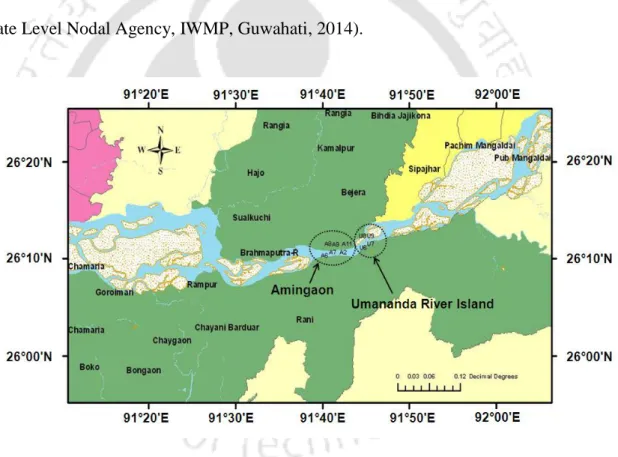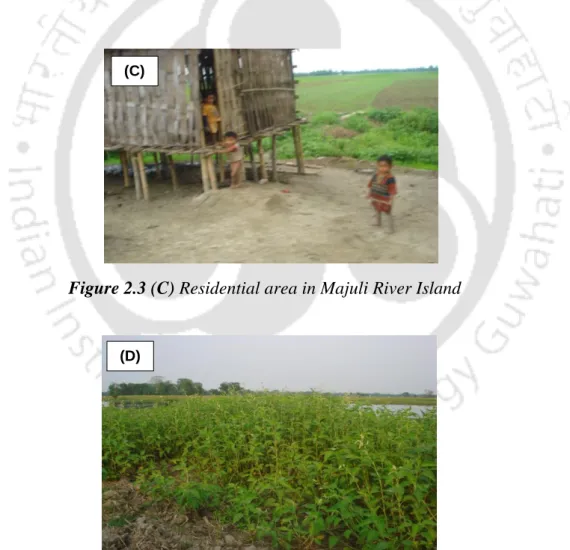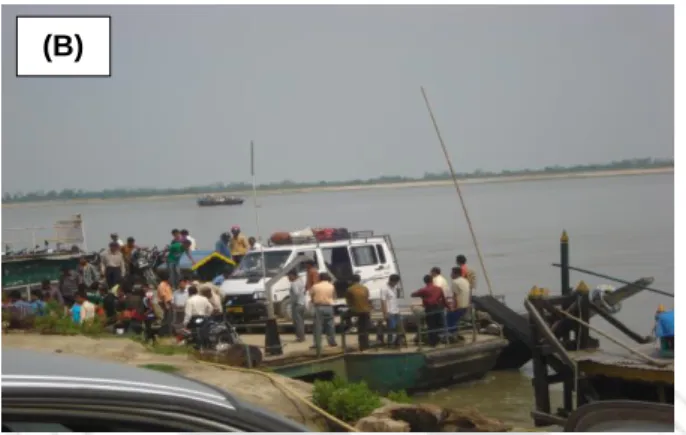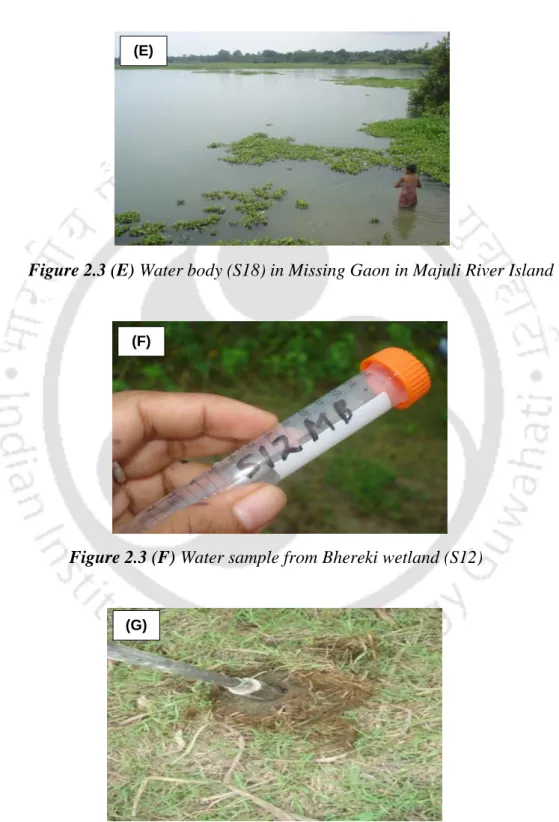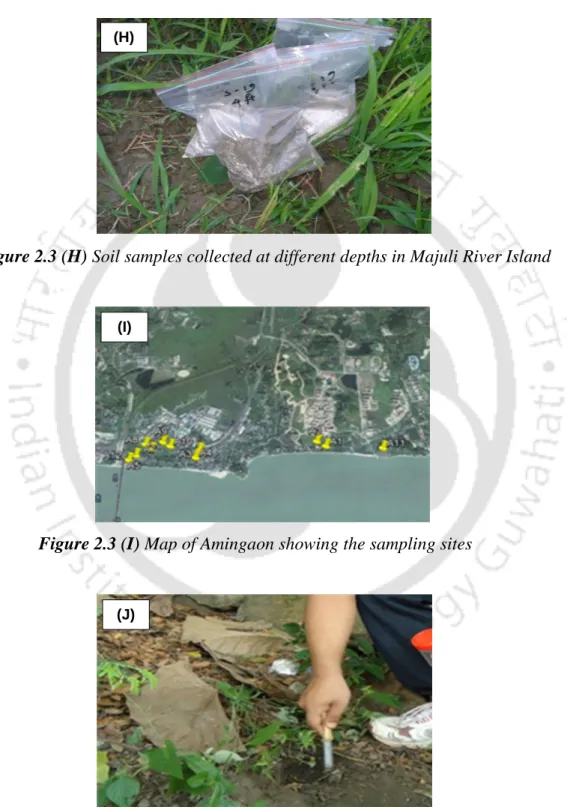I am indebted to the Central Instruments Facility, IITG and Central Library, IITG for providing the necessary facilities. I am grateful to the technical staff of Department of Civil Engineering, IITG and Department of Biotechnology, IITG who have helped me in various ways.
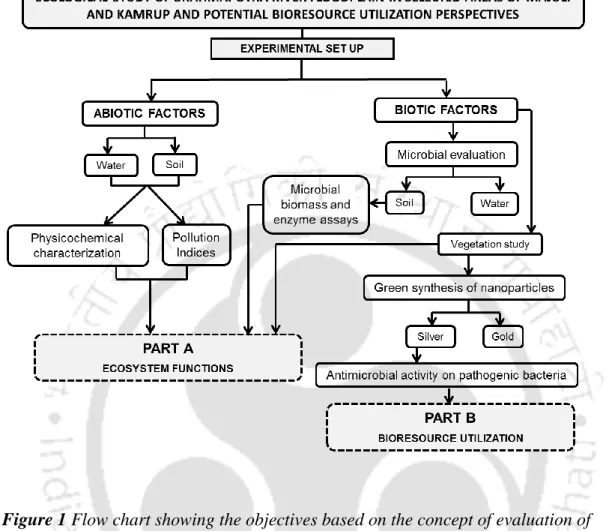
Synopsis
- Introduction and review of literature Part A: Ecosystem Functions
- Chapter 2: Analysis of floodplain characteristics vis-à-vis ecosystem support mechanism and evaluation of soil productivity as a function of nutrient cycling
- Chapter 3: Assessment of metal status and pollution indices in water and soil in Brahmaputra River floodplain
- Comparative assessment of geochemical parameters in two soil typologies i.e. Majuli in the middle stretch and Kamrup in the lower stretch of Brahmaputra River
- Chapter 5: Green synthesis of gold and silver nanoparticles using plant extracts from indigenous plants in Majuli and Kamrup and antimicrobial studies of silver
- Summary and future prospects
- Chapter 1 gave a brief introduction of the concept of ecosystem functions and its significance in a riverine floodplain. Assessment of ecological status of riverine
- involved the physical, chemical and biological components in Majuli River Island in two study periods, pre-monsoon (April, 2011) and monsoon (August, 2011)
- covered the outputs of assessment of metal status in Brahmaputra floodplain extensively highlighting the pollution potential and ecological risk assessment. Single
- provided a comparative assessment of Brahmaputra River floodplain characteristics based on geochemical parameters analysed in both Majuli and Kamrup
- included screening of native plants from Majuli River Island and Kamrup to synthesize gold and silver nanoparticles as a major initiative towards logical
- described an overall summary of the investigations carried out and provided a scope for further research. Majuli River Island represented a pristine ecosystem when
In Majuli River Island, total Fe, Mn, Cu and Pb were visible in water samples. Igeo for Cu and total Fe was higher in Majuli as well as in Kamrup.
List of Tables
ECOLOGICAL STUDY OF RIVERINE FLOODPLAIN
- Concept of ecology
- Types of ecological study
- Ecological study of riverine floodplain all over the world
- Asian countries
- European countries
- Australian countries
- African countries
- American countries
- The Arctic and the Antarctic circles
Scientists have evaluated the physical condition of the river to determine its impact on floodplain ecosystems (Hamilton et al., 1990). Borja et al. (2007) assessed the ecological status of the benthos in the North Atlantic ecoregion.
Ecological study of Brahmaputra River floodplain
- Majuli River Island
- Status of work done in Majuli
- Influence of flooding, erosion and sedimentation
- Influence of crop management activities
- Kamrup: Amingaon and Umananda River Island
- Status of work done in Kamrup
- Influence of urbanization and landuse activities
Located in the heart of the Brahmaputra River in upper-central Assam, Majuli River Island has been designated as one of the world's largest river islands. The cropping pattern in Kamrup provided an overview of the agricultural activities that flourished in the alluvial floodplains of the Brahmaputra River in its lower part.
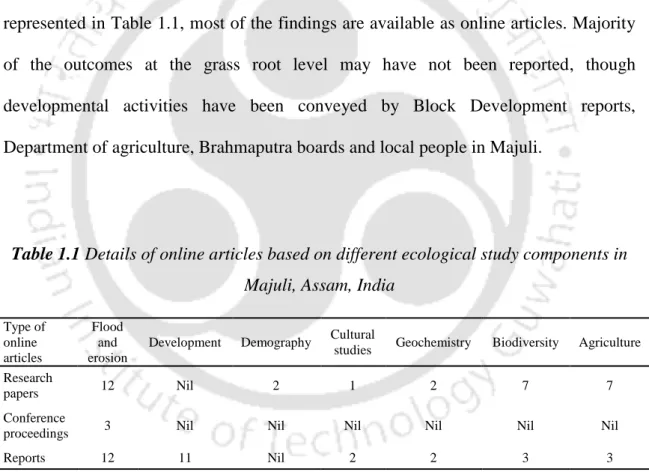
Ecological assessment of floodplain characteristics
- Physicochemical characterization of water samples
- Physicochemical characterization of soil samples
- Microbial evaluation of water and soil samples
- Vegetation study
- Soil microbial biomass characterization
- Soil enzymatic activities
- Pollution indices
- Geostatistical analyses
The physicochemical composition of water is a function of hydrogeochemical processes in rivers and lakes (Matthieu et al., 2005; USEPA, 1983). Actinomycetes as Intrasporangium species were reported on Samoylov Island in the Lena Delta, Siberia (Liebner et al., 2008). Microbial biomass regulates soil fertility and helps trace contaminants in soil (Hargreaves et al., 2003; Broos et al., 2007).
Microbial biomass and significant levels of bacterial productivity in soil are low, depending on geochemical parameters (Trasar-Cepeda et al., 1997). Long-term post-mining succession has similarly shown an increase in soil microbial biomass concentration (Frouz et al., 2005). Microbial biomass also accumulates in municipal solid waste, as reported in the city of Erriadh in Beja (Fourti et al., 2011).
Nutrient mineralization has also been studied as a function of enzymatic activities in the soil (Schimel et al., 2003). Therefore, sediments can be considered as sensitive indicators for monitoring pollutants in aquatic environments (Pekey et al., 2004). Previous studies report that geostatistics provide a basis for interpolation and interpretation of the spatial variability of soil properties (Cambardella et al., 1994).
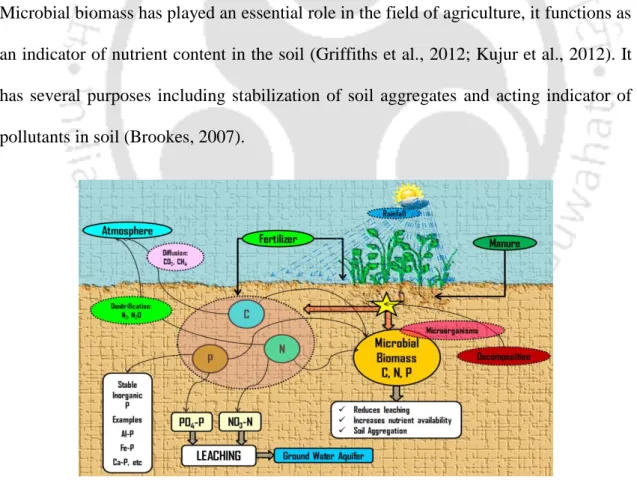
IMPORTANCE OF BIORESOURCE UTILZATION, NOVELS TRENDS IN BIORESOURCE UTILZATION
- Bioresource utilization for green synthesis of nanoparticles
- Some important plant species in Brahmaputra floodplain: Majuli and Kamrup
Sustainable soil and land use is encouraged in spatial correlation studies and a baseline from which further future measurements based on geostatistical analytics can be proposed (Haruna et al., 2013). India has a huge consortium of plant genetic resources (National Bureau of Plant Genetic Resources, Shillong) and contributes to a significant part of the Eastern Himalaya and Indo Burma Hotspot regions (covering Sikkim, Assam and Arunachal Pradesh) (Sandeep et al., 2014). Greater speciation and high genetic diversity correspond to ecological humidity that provides excellent habitat for a diversity of plant and animal species, thus increasing their endemicity to this region (Sandeep et al., 2014; Chatterjee, 1939).
Ti Nepanthaceae, Illiciaceae ken Clethraceae ket sumagmamano kadagiti naisangsangayan unay a henero iti lubong ken nangato nga endemiko iti amianan a daya a rehion (Chatterjee et al., 2006). Ti Ginget ti Brahmaputra ket agkontribusion ti maysa a naipangpangruna a paset ti dagup a panagduduma ti sabong, nangruna ti akin-abagatan a paset ti Karayan Brahmaputra iti rehion ti Indo-Burma a hotspot (Sandeep et al. 2014). Abutilon indicum (L) Sw, Cajanus box Linn., Bryophyllum calycinum Salisb., Drymeria cordata Willd., Mirabilis jalapa Linn., Stephania elegans, H.K., Phylenthus neuri Linn., Bombax ceiba Linn., Eugenia jambulena Lam., Dracaena angustifolia Roxb .., Anonas comosus (L) Merr., Morus indica Linn., Mucona bracteata, Piper nigrum, Musa paradisiaca, Oryza sativa, Cicer arientum (L) Bora (2012) dagitoy a kas ti Acacia farnesian (L) Willd., Achyranthes aspera L , Azadirachta nga indika A.
Br., Curcuma angustifolia Roxb., Curcuma aromatica Salisb., Capsicum annum Linn., Cinnamomum tamala Nees & Eberm, Citrus limon (L) Burm. Kotoky et al (2008) retulit XXIV species herbarum medicamenta adhibita ad medicinas hepatis curandas. Deka et al (1983) indicem similium plantarum quae medicamenta Ayurvedic adhibita sunt, paucae plantae sunt Acacia catechu Willd., Acorus calamus Linn., Andrographis paniculata Nees., Asparagus racemosus Willd., Boerhavia repans Linn., Cleome viscosa Linn. Datura fastuosa Linn., Embelica officinalis Gaert., Gmelina arborea Linn., Holarrhoena antidysenterica Wall., Hydrocotyle asiatica Linn., Mesua ferea Linn., Mangifera indica Linn., Ocimum sanctum Linn., Oroxylon indicum Linn., Paederia faetida Linn. ., Piper longum Linn., Plumbago zeylanica Linn., Ricinus communis Linn., Saraca indica Linn., Sida rhomtfolia Lonn., Tamarindus indica Linn., Terminalia balerica Roxb.,.
Recent trends in nanobiotechnology
- Gold nanoparticles
- Application of gold nanoparticles
- Silver nanoparticles
- Application of silver nanoparticles
- Green synthesis of nanoparticles from plant extracts
- Antibacterial activities of silver nanoparticles synthesized from plant extracts
Jain 2008); nanorobotics (the use of nanorobots that find and localize disease in the human body controlled by an external monitor) (Jain, 2008), nanoscale laser surgery (the combined application of microscopy and nanosurgery to fluorescently labeled structures within cells live) (Sacconi et al., 2005); nanooncology (nanoparticles. The electrocatalytic reduction of CO2 to CO on the surface of GNPs has been recently reported (Zhu et al. 2013). Studies on AgNPs have confirmed their potential application in almost all fields of science (Hettiarachchi et al. , 2011).
Environmentally unfavorable biological resources have nowadays been used successfully to produce environmentally friendly NPs (Sahayaraj et al., 2012). Salicornia brachiate against Staphylococcus aureus, Staphylococcus aureus, Bacillus subtilis and Escherichia coli (Seralathan et al., 2014); Annona squamosa against Bacillus cereus, Bacillus subtilis, Staphylococcus aureus, Staphylococcus typhimurium, Pseudomonas aeruginosa and Proteus vulgaris (Jagtap et al., 2013);
Carthamus tinctorius tegen Escherichia coli, Staphylococcus aureus, Bacillus subtilis en Candida albicans (Sreekanth et al. 2011). Boswellia serrata tegen Escherichia coli, Staphylococcus aureus, Bacillus subtilis, Pseudomonas aeruginosa, Klebsiella pneumonia en Pseudomonas putida (Kudle et al., 2013). Datura metel tegen Micrococcus luteus, Escherichia coli, Staphylococcus aureus en Klebsiella pneumonie (Nethradevi et al., 2012).
PART – A ECOSYSTEM FUNCTIONS
C HAPTER 2
INTRODUCTION
Processes affecting soil quality are more or less dependent on intrinsic and extrinsic factors (Svoray et al., 2004). This vital soil property is affected by the process of humification and mineralization of OM, which occur gradually (Sinsabaugh et al., 1991). Labile forms of elements present in the soil are fixed and available to living organisms through biochemical processes with the help of microorganisms that exist in the soil, mainly bacteria, fungi and actinomycetes (Waldrop et al., 2000).
Nutrients in the soil are thus mineralized by microorganisms, retaining them in smaller but significant amounts. Soil microbial biomass content is directly or indirectly affected by enzymes present in the soil (Bruce, 2005). The most important are classified as extracellular enzymes from various sources of plant or animal or microbial origin and intracellular enzymes restricted to cellular components of living organisms in soil (Pancholy and Rice, 1973).
However, factors such as vegetation, fertilizers, pesticides and agricultural practices affect enzyme activities in soil (Dinesh et al., 2004; Gundi et al., 2007; Hargreaves et al., 2003). Statistical analyzes helped to correlate the experimental variables and derive a functional relationship between the biotic and abiotic parameters in soil samples (all parameters contributing to nutrient mineralization). Vegetation type was studied in wetlands in Majuli and occurrence of similar species was checked in Kamrup.
MATERIALS AND METHODS
- Description of study area .1 Majuli River Island
- Sampling
- Water samples
- Physicochemical characterization
- Most probable number for faecal colonies
- Soil samples
- Analysis of geochemical parameters
- Soil microbial colony forming unit by plate count method
- Soil microbial biomass characterization
- Soil enzyme assays
- Vegetation study by quadrat method
- Statistical Analysis
Majuli River Island is located in the heart of the Brahmaputra River in the upper middle part of Assam in Northeast India. The lithogenic composition varies from sandy loam to clay loam (Singh, 2011). The unique landform in Majuli is divided into seven significant geomorphic units: 1) Active floodplains, 2) Grass-covered sandbanks, 3) Sandbanks, 4) Swamps, 5) Old floodplains, 6) Channel fills and 7) Natural levees (NBSS and LUP, ICAR, 2006). Water and soil samples were collected from wetlands on Majuli River Island [Table A 2.1 (A), (B), Appendix 2].
The study sites in Kamrup are Amingaon, located on the mainland near the bank of the Brahmaputra River in the north of Guwahati, and the river island of Umananda or Peacock Island, which lies northeast of Guwahati (Figure 2.2). Most of the Kamrup district is occupied by the Brahmaputra river in the center of Guwahati city. Amingaon and Umananda experience a tropical wet monsoon climate in Kamrup district, lying at an altitude of 31-55 m above mean sea level, depending on the terrain.
The geomorphology of the study area represents an alluvial soil form occurring in the family of Aquic Udifluvents (Vadivelu et al., 2004), desirable for agricultural activity. In the first group, the soil samples were treated with 0.2 mL toluene, in the second group the samples were analyzed for enzyme activity without toluene. Vegetation survey through Quadrat method was conducted in Majuli Island in pre-monsoon season only because there was no significant difference in monsoon season vegetation.
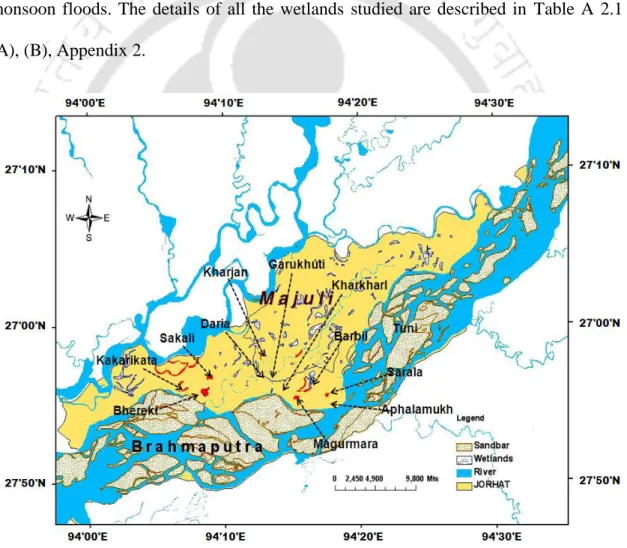
RESULTS AND DISCUSSIONS
- Ecological status of water and soil in Majuli and Kamrup
- Nutrient mineralization in soil samples
- Role of microbial biomass and soil enzymes activities in soil fertility and productivity
- Influence of geochemical parameters on the biotic factors in soil
All analyzed parameters were within the permissible limits specified by BIS (Table 2.3), WHO and EPA, except pH (in a few samples) and DO (Table A 2.2, Appendix 2). Overall analysis revealed that in pre-monsoon and monsoon season, pH, EC, turbidity, NO3-, DO and ammonia showed relatively higher values in group A (residential areas) (Table A 2.2, Appendix 2). In general, among all the physicochemical parameters analyzed, DO, COD and ammonia were observed to be relatively higher in monsoon season [Table A 2.2, Appendix 2].
Details of trace elements and their indexing for suitability in drinking, household and agriculture are given in Table 2.3 and Table 2.1 respectively. The particle size distribution confirmed the sandy loam nature of the soil samples (except for bank sediments) at Majuli as well as Amingaon and Umananda, at a depth of 0 – 20 cm. However in Amingaon and Umananda, CNP status in Majuli was positively correlated with pH, EC, CEC, BCFU, FCFU and grain size distribution [Table A 2.7 (A), (B), Appendix 2].
The change in two seasons was significant in Majuli as well as in Amingaon and Umananda. In Amingaon and Umananda, soil enzyme analysis describes the fertility and extent of productivity in the soil. Enzyme activities and nutrient mineralization in Majuli were positively correlated in both pre-monsoon and monsoon season [Table A 2.8 (A), (B), Appendix 2].
CEC showed positive correlations with most of the enzyme activities in Majuli as well as Kamrup (Amingaon and Umananda). Outputs of some of the significant regression analyzes are given in Tables 2.6 and 2.7. SOM in pre-monsoon as well as monsoon seasons showed positive correlation with MBC.
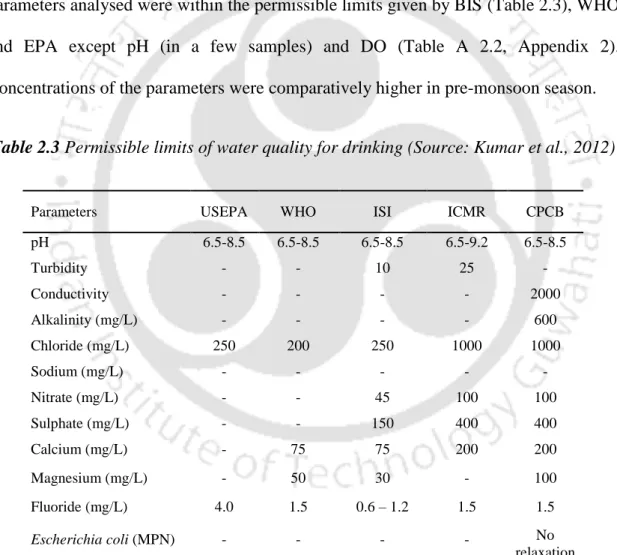
CONCLUSIONS
![Table 4.7 Component matrix showing 2 PCs each, extracted for the sampling sites in Majuli, Amingaon and Umananda, number of PCs and their absolute loadings correspond to the rotated plots in [Figure 4.19 (A), (B)], in pre-monsoon s](https://thumb-ap.123doks.com/thumbv2/azpdfnet/10499095.0/26.892.153.758.336.917/component-extracted-sampling-amingaon-umananda-absolute-loadings-correspond.webp)
